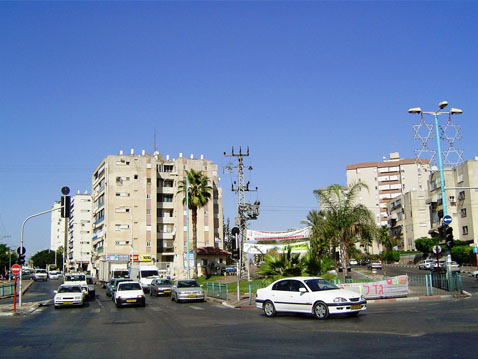Parashat Baha'alotecha: sanctity of holy scriptures vs. sanctity of teruma

The difference between the innately sacred and sanctified physicality. Also: the varying definitions of a "distant journey" to Jerusalem for the Pesach sacrifice, ma'aser sheni, and neta revay, plus a visit to Lod, ancient and modern.
One of the complex issues in relationships between full-time learners and good Jews who didn't merit to learn much Torah is the awkward moment when the latter doesn't understand why his friend in kollel doesn't attend a se'udat mitzva and the like. "It's also a big mitzva!" He'll tell his friend the kollel fellow, when the latter explains that he doesn't want to stop studying Torah (bitul Torah). How can he explain to his friend—whose claim is justified—that nevertheless, Torah study is something else altogether, a whole different level of sanctity?
One of the more puzzling institutions enacted by Chazal is that on the Holy Scriptures. The two-part injunction is that Holy Scriptures (the books of Tanach, when written on parchment) transmit impurity and nullify teruma if the two touch each other. The reasoning for this paradoxical injunction, which turns a sacred book into a source of impurity, is that there were times when people thought that since both teruma and theses scriptures are sacred, the two should be stored together. The problem was that animals were attracted to the teruma (which is food, after all), and while munching away at the teruma produce, would also nibble at the scriptures, which destroyed and desecrated them. So to prevent people from storing teruma next to the holy scriptures, Chazal instituted that these writings would transmit impurity. The second stage was that these writings would transmit impurity to one who touches them with their hands (tumat yadayim), which too, would disqualify the teruma when touched (see Rambam's gloss on the Mishna 3:3). It is interesting to note that this impurity became the litmus test to determine if a book was included in the holy canon of Tanach. In this way, if it transmits impurity to hands, it essentially is sacred (Mishna Yadayim 3:6).
It seems that while this distinction drawn between the sanctity of holy scriptures and other sanctities (teruma, in our case) is a product of a situation that Chazal wanted to prevent, in their injunction Chazal wanted to emphasize an another issue as well. There are different types of sanctity, and who shouldn't get confused or think they are all the same. Even if someone achieves the trait of kedusha, sanctity, as defined by the Path of the Just, he will still make havdala at the conclusion of Shabbat "between the sacred and the mundane." This is despite the fact that: "Behold, for the man sanctified with the holiness of his Creator, even his physical deeds become actual matters of holiness" (Path of the Just, chapter 26). Even so, we need to distinguish between "sanctity of the sacred" and "sanctity of the mundane."
Sanctity of the sacred vs. sanctity of the mundane
Here is the place for an important question: we have discussed previously that G-d desires an earthly abode and the purpose of creating the world is to reveal His kingship and unity in this physical world. If so, why isn't sanctity of this kind more elevated, or at least on par, with so-called "regular" sanctity—that is, sanctity that is sacred from its inception?
The answer to this is hinted at in the passage of "When the Ark was to set out" (ויהי בנסוע הארון)" (Bamidbar 10:35–36). Chazal state that these two verses constitute are a book unto itself, which is why the two inversed nuns set off the verses. This portion is bookmarked by negative events: "And they journeyed from the mountain of the L-rd" ("Like a child fleeing from school," Tanchuma) and the sin at Kivrot Hata'ava. This portion, however, is in no way influenced by its surroundings. It retains pristine in its sanctity and uplifts anyone who reads it—exuding a sense of G-d's greatness, which also reflects on the greatness of the Jewish people ("And those who hate You" – These are those who hate [the people of] Israel, for whoever hates Israel hates the One Who spoke and brought the world into being" [Rashi, Bamidbar 10:36]).
This world might contain evil, but it is also full of extraordinary goodness. However, the goodness in this world is often relative, it fluctuates, and can be influenced by its surroundings. After all, we live in a physical world full of desires and physical drives. Sometimes people feel that intense sanctity is too overwhelming for them and they flee from it like children running away from school. Others succumb to their base drives, like those described in the portion of the mitonenim at Kivrot Hata'avah. Those who want to ensure that they are bound up with eternal goodness must cleave to the Ark, which contains the Torah given to us at Mt. Sinai. This bond to Torah ensures that keeps us bound to the eternal truth and goodness (of course, providing that the connection to Torah is grounded in refined character traits and is for the sake of Heaven). Through this bond, one can approach the world and rectify it. However, the false notion that there is no need for Torah, and the world itself is sacred—like the teruma, which is essentially fruit or produce that is sanctified—is dangerous. Instead of uplifting the physical world, it degrades it and desecrates the Torah. It is precisely this knowledge that the sacred (kodesh) and mundane (chol) do exist, and that we must strive to sanctify the latter, but not transform it into an independently sacred entity—it is this that can truly sanctify the world. To the point where "even the bells on the horses shall be inscribed 'Holy to the L-rd'" (Zechariya 14:20).
Lod: Jerusalem's western border
"Speak to the Israelite people, saying: When any of you or of your posterity who are defiled by a corpse or on a long journey would offer a Passover sacrifice to the L-rd … But if a man who is clean and not on a journey refrains from offering the Passover sacrifice, that person shall be cut off from his kin, for he did not present the L-rd's offering at its set time; that man shall bear his guilt" (Bamidbar 9: 10-13).
"What is a 'long journey'? From Modi'it and beyond and the same distance on all sides [of Jerusalem], the words of Rabbi Akiva" (Mishna Pesachim 9:2).
"[The produce of] a vineyard in its fourth year was brought up to Jerusalem within a distance of one day's journey on each side. And what is the border [of a day's journey on each side]? Eilat to the south, Akrabat to the north, Lod to the west, and the Jordan [river] to the east. When the produce increased, it was decreed that it can be redeemed even if the vineyard was close to the wall. And there was a stipulation on this matter—that whenever it was so desired, the arrangement would be restored as it had been before. Rabbi Yose says: this was the stipulation when the Temple was destroyed. And the stipulation was that when the Temple should be rebuilt the arrangement would be restored as it had been before (Mishna Ma'aser Sheni 5:2).
Distance from Jerusalem for Pesach Sheni
We discussed this mishna in the past in the context of the northern border. We explained that according to Torah law, it would be possible to redeem neta revay, fourth-year-fruit (and ma'aser sheni produce) up until the walls of Jerusalem—and the money can then be used to purchase food in Jerusalem itself. However, the Sages instituted that people bring the sacred fruit itself up to a certain radius from Jerusalem "to deck out the markets of Jerusalem with fruit." According to Rabbi Yose, this ordinance was nullified upon the destruction of the Temple (which is the halacha), since there were no longer markets to bedeck. However, when the Temple is rebuilt, this ordinance will be instituted once again and fruit will not be redeemable near Jerusalem's walls.
It is interesting that the Sages fixed different distances from Jerusalem (defining "a long journey") for the Pesach sacrifice and for ma'aser sheni and neta revay. For ma'aser sheni, the four settlements above define the distance. The Mishna names a different location to define the "long journey" for the Pesach sacrifice (exempting individuals living beyond this area from karet should they fail to offer the sacrifice on time): "from Modi'it and beyond and the same distance on all sides [of Jerusalem]." This is much closer to Jerusalem; most probably Kafr al-Midya, identified as the Modi'in of the Hasmoneans. The reason for this is that the journey for the Pesach offering is defined as much shorter: it is the walking distance from the early morning until the time for of sacrificing the Pesach offering, which is after midday (chatzot hayom) (according to Ulla [Pesachim 93b], whose opinion Rambam follows: Hilchot Korban Pesach 5:8). For ma'aser sheni and neta revay, the distance is a full day's journey on foot.
Lod: A walled city, home of the Tana'im
There is no doubt about the location of Lod. The city, situated on the coastal plains is a major city, past and present. It is located at the center of the Ono Valley (the "Lod Plains" mentioned by the Mishna in the context of bi'ur for shemita produce). Lod is one of the most ancient cities in the world and is considered a walled city from the time of Yehoshua Bin Nun. In the early Second Temple period it was resettled by Jews. Towards the end of the Second Temple period, during the Great Rebellion, Cestius Gallus found merely 50 inhabitants there, for the simple reason that everyone else had made the pilgrimage to Jerusalem. The Roman officer burned the city and killed everyone who had remained.
Following the Temple's destruction, several great Tana'aim lived there, including Rabbi Eliezer ben Horkanos and Rabbi Tarfon. For a period, it was an important Jewish center. Following the Bar Kochba Rebellion, during which one of its centers was in Lod, the city was rehabilitated but did not return to its former spiritual status. After additional rebellions, the city became destitute, and was considered a poverty-stricken area. Upon the Arab conquest of the Land of Israel, the urban center relocated to Ramle—the only city established by Arabs in the Land of Israel. Nevertheless, Lod continued to exist.
Lod Today
Lod was conquered during the War of Independence in Operation Danny (originally called Operation L.R.L.R. because of the four major settlements that were the objectives of the mission: Lod, Ramle, Latrun, and Ramallah; only the first two were actually conquered). Most of its Arab inhabitants fled. Jewish residents were brought there from the transit camps (ma'abarot) and the Arab population began to return. Today the city is mixed.
Lod is a mixed city and more than a quarter of its population are Arabs. To strengthen the Jewish identity of this ancient city with a prominent place in the history of the Oral Torah, one of the more veteran and successful Torah cadres (garin Torani) came to settle in the city. This cadre, which includes more than 700 families (as of 5779) located throughout the city's neighborhoods, works closely with the municipality to strengthen the Jewish presence in the city and to attract new families. They hooked up with the existing Chabad community; the concentration of more than 550 Chabad families live in Lod's Chabad neighborhood.

Lod




